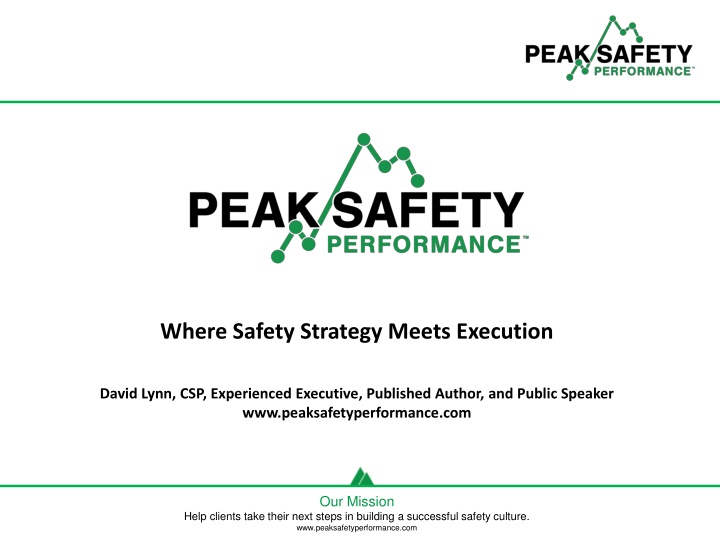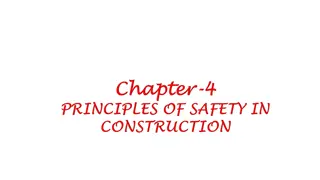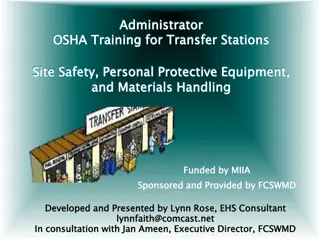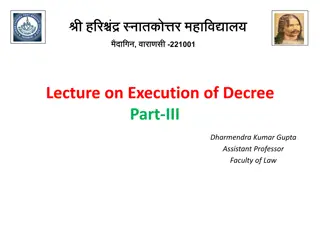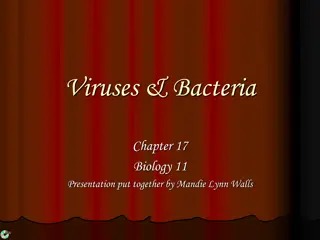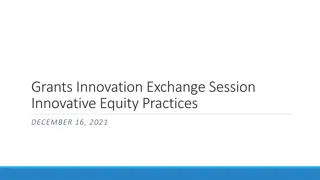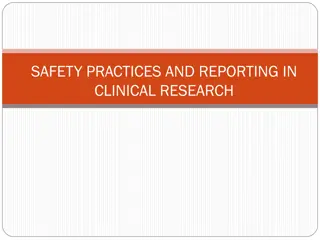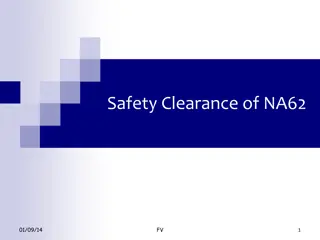Safety Strategy Meets Execution with David Lynn
In the intersection of safety strategy and execution lies the expertise of David Lynn, a seasoned executive, author, and public speaker. His mission is to guide clients towards a successful safety culture through workshops, presentations, and practical tools. Topics include risk perception, prevention techniques, communication strategies, and habit formation. Explore the keys to mitigating risks and building safe habits for sustainable safety practices.
Download Presentation

Please find below an Image/Link to download the presentation.
The content on the website is provided AS IS for your information and personal use only. It may not be sold, licensed, or shared on other websites without obtaining consent from the author.If you encounter any issues during the download, it is possible that the publisher has removed the file from their server.
You are allowed to download the files provided on this website for personal or commercial use, subject to the condition that they are used lawfully. All files are the property of their respective owners.
The content on the website is provided AS IS for your information and personal use only. It may not be sold, licensed, or shared on other websites without obtaining consent from the author.
E N D
Presentation Transcript
Where Safety Strategy Meets Execution David Lynn, CSP, Experienced Executive, Published Author, and Public Speaker www.peaksafetyperformance.com Our Mission Help clients take their next steps in building a successful safety culture. www.peaksafetyperformance.com
Time (minutes) Workshop Day 2 Introduction Vision & Purpose 15 Risk Perception: Why do we take chances? Module Two Presentation: Individual Prevention Tools & Techniques 1. Stop When You Are Unsure Questioning Attitude 60 2. SAFE Dialogs Prevention begins with a conversation 3. STAR (Stop Think Act Review) 4. FACTS (Foresee-Ask-Confirm-Test-Stop) Group Exercise: Plant Walk Using One of the Tools Break 45 15 Our Mission Help clients take their next steps in building a successful safety culture. www.peaksafetyperformance.com
Time (minutes) 60 Workshop Day 2 Module Three Presentation: Supervisors Prevention Tools & Techniques 1. Preplan your work. 2. Conduct a post job review. 3. Three keys to great communication. 4. Audit your jobs. Discussion: Open Discussion Wrap-up 15 15 Our Mission Help clients take their next steps in building a successful safety culture. www.peaksafetyperformance.com
Risk Perception Why do we take chances? Module 2: Individual Prevention Tools & Techniques Our Mission Help clients take their next steps in building a successful safety culture. www.peaksafetyperformance.com
Create SAFE HABITS Our Mission Help clients take their next steps in building a successful safety culture. www.peaksafetyperformance.com
Create SAFE HABITS FIRST - Understand that the injury can happen to YOU! Have a Questioning Attitude Review Task (SAFER) Self Check (STAR) Individual Tools Stop When Unsure Follow Procedures/Rules Communicate Review the Jobsite Audit the Task/Job Leadership Tools Perform Pre-Job Brief Conduct Post Job Review Our Mission Help clients take their next steps in building a successful safety culture. www.peaksafetyperformance.com
Creating Keystone Habits 40% of actions people perform each day are not decisions. They are habits. Habits form to save effort. (pg. xvi) GOAL: Create Habits That Recognize & Mitigate Risk. Reference: The Power of Habit, Charles Duhigg Our Mission Help clients take their next steps in building a successful safety culture. www.peaksafetyperformance.com
Creating Keystone Habits Keystone habits say that success doesn't depend on getting everything single thing right, but instead relies on identifying a few key priorities and fashion them into powerful levers. (pg. 100) Cultures grow out of the keystone habits in every organization, whether leaders are aware of them or not. (pg. 124) Reference: The Power of Habit, Charles Duhigg Our Mission Help clients take their next steps in building a successful safety culture. www.peaksafetyperformance.com
Creating Keystone Habits New habits are created: by putting together a cue, a routine, and a reward, and then cultivating a craving that drives the loop. (pg. 49) Reference: The Power of Habit, Charles Duhigg Our Mission Help clients take their next steps in building a successful safety culture. www.peaksafetyperformance.com
Creating SAFE HABITS Have a Questioning Attitude Review Task (SAFER) Self Check (STAR) Stop When Unsure Follow Procedures/Rules Communicate Review the Jobsite Audit the Task/Job Perform Pre-Job Brief Conduct Post Job Review Our Mission Help clients take their next steps in building a successful safety culture. www.peaksafetyperformance.com
Creating Keystone Habits Develop Keystone Habits That Influence Risk Decisions Have a Questioning Attitude Review Task (SAFER) Self Check (STAR) Stop When Unsure Follow Procedures/Rules Communicate Review the Jobsite Audit the Task/Job Perform Pre-Job Brief Conduct Post Job Review Our Mission Help clients take their next steps in building a successful safety culture. www.peaksafetyperformance.com
Risk Perception Why do we take chances? Prevention Tools & Techniques Questioning Attitude Get the FACTS Our Mission Help clients take their next steps in building a successful safety culture. www.peaksafetyperformance.com
Questioning Attitude People think that activities always go as planned. A questioning attitude fosters situation awareness. It encourages thought about safety before action is taken. It encourages workers to stop and resolve hazards. Our Mission Help clients take their next steps in building a successful safety culture. www.peaksafetyperformance.com
How to QUESTION Get the FACTS F-oresee (critical activities) A-sk open-ended questions C-onfirm knowns and unknowns T-est the current situation S-top when uncertain Our Mission Help clients take their next steps in building a successful safety culture. www.peaksafetyperformance.com
When to Use Confusion or Doubt Something is not right When you hear the words: I assume, probably, I think, maybe, should be, not sure, might, we ve always, and so forth Our Mission Help clients take their next steps in building a successful safety culture. www.peaksafetyperformance.com
Summary Questions raise awareness. Questions help you avoid blind spots. Questions reveal risk. Questions encourage you correct hazards. Questions show where things may go wrong. Our Mission Help clients take their next steps in building a successful safety culture. www.peaksafetyperformance.com
Risk Perception Why do we take chances? Prevention Tools & Techniques Task Review - SAFE Dialogue Our Mission Help clients take their next steps in building a successful safety culture. www.peaksafetyperformance.com
SAFE Dialogues SAFE Dialogues are a tool to raise situation awareness by talking about job steps, potential errors, consequences, and solutions. SAFE Dialogues require people to question the steps in a job and anticipate hazards. Our Mission Help clients take their next steps in building a successful safety culture. www.peaksafetyperformance.com
SAFE Dialogues SAFE Dialogues help promote situation awareness through frequent questions and conversations. The SAFE Dialogue promotes management visibility and it encourages a questioning attitude. Our Mission Help clients take their next steps in building a successful safety culture. www.peaksafetyperformance.com
SAFE Dialogue Accepted Practice: Summarize the critical steps Anticipate errors for each critical step and relevant error precursors Foresee probable and worst-case consequences should an error occur during each critical step Evaluate controls or contingencies at each critical step to prevent, catch, and recover from errors, and to reduce their consequences Our Mission Help clients take their next steps in building a successful safety culture. www.peaksafetyperformance.com
When to Use the Tool Site visits Conducting audits Before starting a job Prior to a pre-job brief Just before performing a critical step After extended delays in an activity Our Mission Help clients take their next steps in building a successful safety culture. www.peaksafetyperformance.com
Summary Prevention can start with a conversation! Clarify risk and solve problems with a SAFE Dialogue. Our Mission Help clients take their next steps in building a successful safety culture. www.peaksafetyperformance.com
Risk Perception Why do we take chances? Prevention Tools & Techniques STAR - Self Check Our Mission Help clients take their next steps in building a successful safety culture. www.peaksafetyperformance.com
STAR - Self Check Self-checking helps people focus on the action. Self-checking helps you understand the expected outcome before acting. Self-checking encourages you to verify the results. Self-checking boosts attention before an action is performed. Our Mission Help clients take their next steps in building a successful safety culture. www.peaksafetyperformance.com
STAR S- top before each step T- hink about the hazards A- ct within safe work scope R- eview work Our Mission Help clients take their next steps in building a successful safety culture. www.peaksafetyperformance.com
When to Use Stop before critical steps. Stop when unsure. Stop to verify results. Stop to clarify questions. Stop to gain understanding. Our Mission Help clients take their next steps in building a successful safety culture. www.peaksafetyperformance.com
Summary You control your focus! Think through every step. Our Mission Help clients take their next steps in building a successful safety culture. www.peaksafetyperformance.com
Risk Perception Why do we take chances? Prevention Tools & Techniques Stop When Unsure Our Mission Help clients take their next steps in building a successful safety culture. www.peaksafetyperformance.com
Stop When Unsure Gain more accurate information about the work situation before proceeding with the activity. A brief stoppage of work to allow workers, their supervisor, or other knowledgeable persons to discuss the issue before resuming the task. Our Mission Help clients take their next steps in building a successful safety culture. www.peaksafetyperformance.com
When to Stop When uncertainty, doubt, confusion, or questions persist. If outside of conditions assumed by a technical procedure. When encountering conditions inconsistent with the procedure. If beyond the scope of the plan or process. Our Mission Help clients take their next steps in building a successful safety culture. www.peaksafetyperformance.com
Summary Uncertainty increases mistakes. If you don t know what to do, stop and ask! Get information from knowledgeable people. Think through the steps. Observe what is going on around you. Our Mission Help clients take their next steps in building a successful safety culture. www.peaksafetyperformance.com
Group Exercise Our Mission Help clients take their next steps in building a successful safety culture. www.peaksafetyperformance.com
Purpose The purpose of this module is to: Emphasize the importance of analyzing work and identifying hazards. Offer techniques to increase to increase risk perception. Our Mission Help clients take their next steps in building a successful safety culture. www.peaksafetyperformance.com
